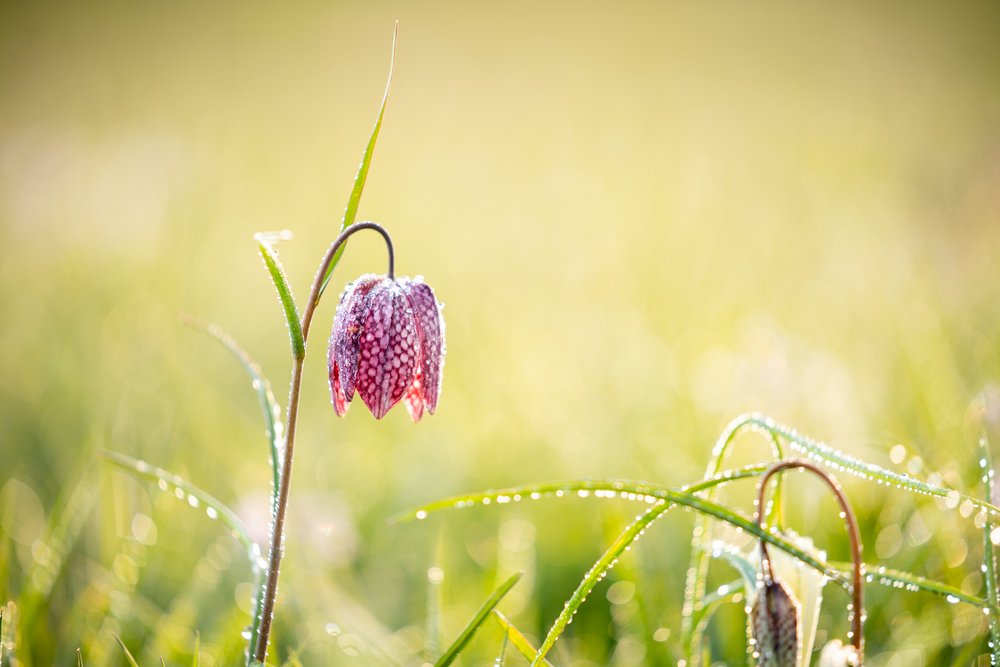The snake’s head fritillary (Fritillaria meleagris) is an impressive flower known for its unique and intricate appearance. With a bell-shaped bloom that comes in shades of purple, pink or white – this species of flowering plant has captivated the attention of gardeners and wildlife enthusiasts alike. But what exactly makes the snake’s head fritillary so special? To answer that question, we must delve into its pollination habits, reproduction cycle and how to grow it yourself at home. In this article, you’ll learn all about Fritillaria meleagris: from its stunningly beautiful blooms to understanding how best to care for them. So if you’re curious about these incredible flowers – keep reading!
Overview
Fritillaria meleagris, commonly known as the snake’s head fritillary, is a species of flowering plant in the lily family. It is native to Europe and western Asia and has been introduced to North America. It has many aliases, including snake’s head, guinea flower, frog-cup, chess flower, guinea-hen flower, drooping tulip, chequered lily, chequered daffodil, and many more.

Snake’s Head Fritillary Appearance
The snake’s head fritillary grows from 10-30 cm tall with slender stems that bear small bell-shaped flowers at their tips.
The flowers are usually purple or white but can also be pink or yellowish in colour. They have six petals arranged in two whorls around a central cup-like structure called an umbel which contains many tiny stamens and pistils. The petals are often mottled with darker spots or streaks, giving them a checkered appearance reminiscent of a snake’s skin patterning.
The leaves of Fritillaria meleagris are narrow and linear, growing up to 15 cm long by 1 cm wide on average. They grow opposite each other along the stem in pairs and may be either smooth-edged or slightly serrated, depending on the variety.

Pollination
Pollination is a vital process for the reproduction of many plants, including snake’s head fritillary. This species of flower has an interesting and unique pollination system.
The flowers are self-incompatible, meaning that they cannot be fertilised by their own pollen. Instead, they rely on insects to move pollen from one plant to another. The most common insect visitors include bumblebees and solitary bees such as Andrena nigroaenea and Osmia rufohirta. These bees are attracted to the nectar produced by the flowers, which provides them with food in return for transferring pollen between plants.
In addition to these insects, hoverflies also play an important role in pollinating Fritillaria meleagris. Hoverflies have been observed visiting both male and female flowers in search of nectar, but it is not known if they transfer any significant amount of pollen between plants or if their visits are mainly focused on feeding rather than pollination.
The shape of the flower also plays a part in its successful pollination; its curved petals make it difficult for larger insects like honeybees to access the nectar within without brushing against the stigma (the female reproductive organ) at least once during each visit, thus ensuring that some viable pollen is transferred from one plant to another when visiting multiple flowers across different individuals or patches of this species throughout its range.
Reproduction
It reproduces both sexually and asexually, making it an interesting species to study.
Sexually, the snake’s head fritillary produces seeds through pollination by insects such as bees and butterflies. The flowers have two distinct parts: the male part called stamens which produce pollen; and the female part called pistils which receive pollen from other flowers of the same species. When this happens, fertilization occurs, and seeds are produced.
Asexually, reproduction takes place when bulbs form on underground stems known as rhizomes or corms. These bulbs will eventually develop into new plants with identical characteristics to their parent plant – they are clones of each other. This method of reproduction allows for rapid spread across an area without relying on pollinators like bees or butterflies for successful seed production.
The snake’s head fritillary also has another way of reproducing – vegetative propagation via division or separation of its clumps or tufts at any time during its growing season (spring). By dividing these clumps, you can create multiple new plants that will grow rapidly due to their already-established root systems.
No matter how it reproduces, one thing is certain: Fritillaria meleagris is a fascinating species that offers many opportunities for observation and research.
How To Grow Fritillaria Meleagris
Growing this unique flower in your garden can be rewarding and relatively easy if you follow these steps:
Location
Snake’s head fritillary prefers cool climates with plenty of moisture and indirect sunlight. Choose a spot in your garden that gets some shade during the day but still receives enough light for photosynthesis to occur. The soil should be well-draining yet moist; adding compost or manure will help improve drainage while also providing essential nutrients for growth.
Planting
Plant bulbs 4 inches deep into the soil with their pointed ends facing up. Space them 6 inches apart from each other so they have room to grow without overcrowding one another. Water thoroughly after planting and keep the area moist until new shoots appear above ground (usually takes about two weeks).
Care & Maintenance
Once established, snake’s head fritillary requires minimal maintenance beyond regular watering when conditions are dry or hot outside. Deadheading spent blooms will encourage more flowers throughout the season, while applying fertiliser every few months can help maintain healthy foliage growth over time. In colder climates, mulching around plants may provide extra insulation against frost damage during winter months; however, avoid using too much mulch as this could cause root rot due to excessive moisture retention near plant roots.
Additional Resources
Sources and References
- Fritillaria Meleagris – rhs.org.uk
- Snake’s Head Fritillary Flower: Planting, Care & Propagation – plantura.garden

Ash is a contributing author who has been writing about wildlife for as long as he can remember. He has a vast knowledge of many different types of animals, from the tiniest shrews to the great whales that live in the deepest oceans.
